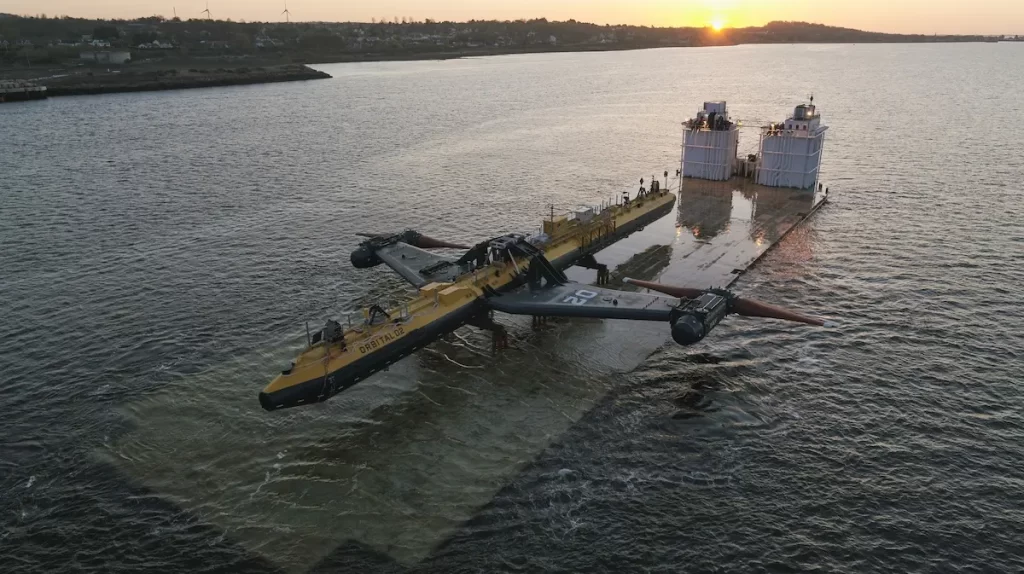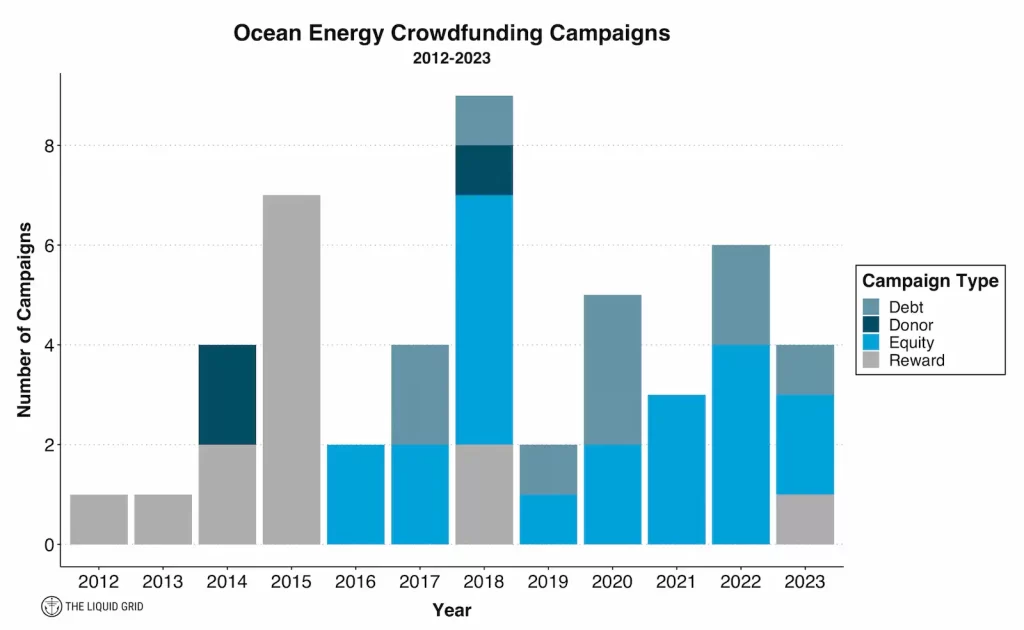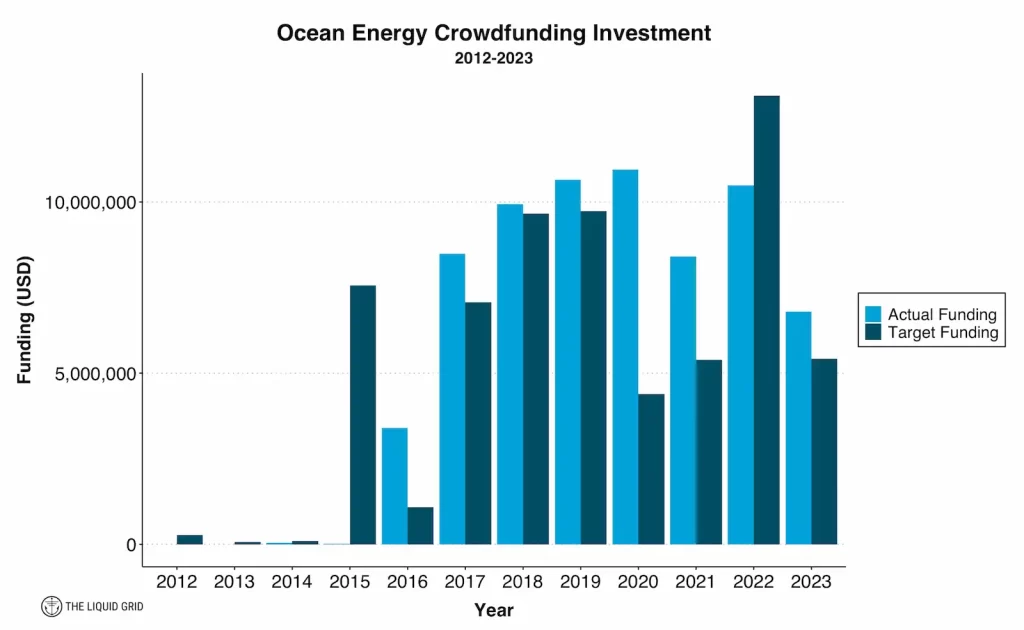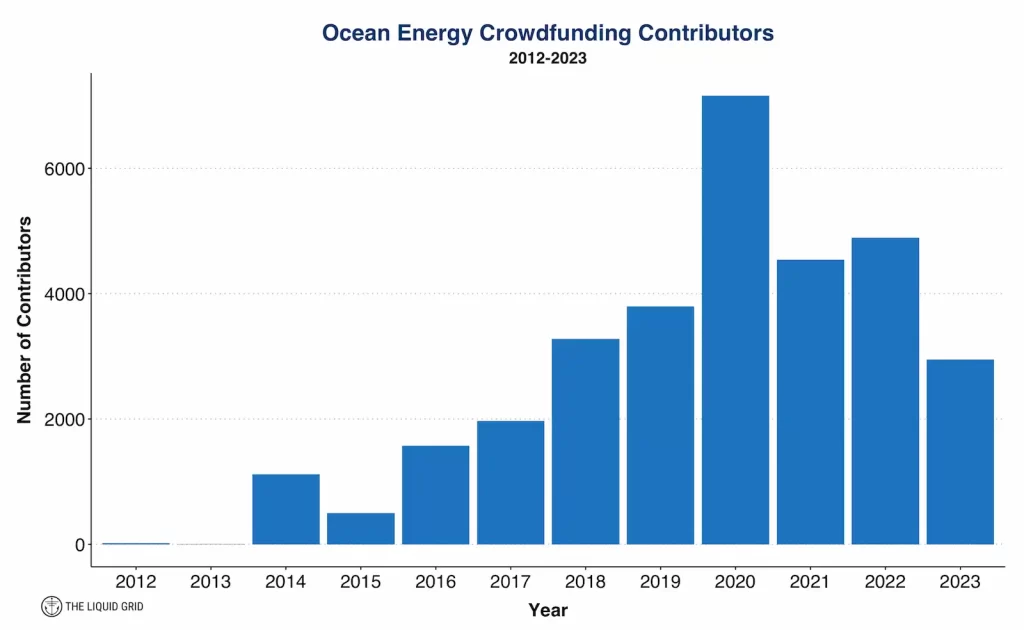Over the past decade ocean energy crowdfunding has attracted no fewer than 30,000 investors and $69 million. What’s fueling this surge in crowdfunding for ocean energy technologies?
Ocean energy start-ups have it rough. They face the mundane tasks of any new business, like finding an office space, as well as the more complex challenge of building hardware that survives for years in the ocean. Before a wave or tidal energy system is connected to the grid and delivering power there are countless tests, permits, models, and site assessments that take significant time and money.
Funding Sources and Risks
Start-ups raise funds from a variety of sources, including angel or impact investors, venture capitalists, family and friends, corporate funds, or government grants. No matter who provides the funds, each balances the risk of losing their investment against the potential upside of seeing a return.
Ocean energy start-ups are risky endeavors. Operating systems in the ocean is hard, especially when they are intentionally placed in energetic locations with intense waves or strong currents, and then expected to operate reliably for years or decades. In fact, ocean energy technologies are the epitome of deep tech. Even before the final system is deployed, there are years of designing, testing, prototyping, and permitting. It might be ten years before any returns are seen by investors. Start-ups are inherently risky, but relative to other start-ups, those focused on ocean energy are particularly so. But the rewards of harnessing the ocean’s as-yet-untapped energy resources are immense.
“Fundraising for ocean energy is inherently more difficult than in other tech sectors,” according to Christopher Milne, Chief Financial Officer at Orbital Marine Power, a tidal energy company.

“There are three main challenges for ocean energy companies: hardware of this scale requires large capital commitments, even for first-of-kind demonstrations; for long periods and in most regions, there have been a lack of credible routes to market; and there remains self-inflicted headwinds from past failed projects. Over the last decade or two, there were several relatively high profile and significant investments made in ocean energy technologies, but none have resulted in real commercial or economic success, which increases the investment markets’ perception of financial risk.”
There are few investors that have the patience and the risk appetite. Suffice to say it can be challenging for ocean energy start-ups to raise capital.
Some ocean energy start-ups get funding from government agencies, like the U.S. Department of Energy’s Water Power Technologies Office (WPTO). This office provides tens of millions of dollars each year towards ocean energy research and market development. However, these competitive grants are typically available only once a year for very specific research topics. Infrastructure grants are another source of capital, but these can be too large for ocean energy start-ups and very risk adverse.
“There is a very active and supportive universe of early stage investors such as angels and VCs at one end of the spectrum, as well as a very crowded market of large scale infrastructure style funds at the other, lower risk, mature technology, end of the spectrum. Our funding needs are often too small for the latter and too large for the former, which puts us in an awkward position. There are few options when looking for that in-between area of scale-up growth capital,” Chris explains.
With limited options, ocean energy start-ups sometimes turn to less traditional fundraising methods, like crowdfunding.
Ocean Energy Crowdfunding
Reward-based and donor crowdfunding has been around since 2008 when the likes of Indiegogo and Kickstarter launched. But it was only around 2016 when non-accredited investors could participate in debt and equity financing through crowdfunding. This grew the investor pool significantly and democratized access to capital for start-ups. Your author first started tracking ocean energy crowdfunding in 2018, and over the last five years it has become increasingly common for wave and tidal energy companies.
“We typically see that institutional and professional investors are looking for a high-risk rate of return, but without actually carrying the risk; normally looking for contractual protections and guarantees that sticks the risk with the developer. This is often simply not feasible depending on balance sheet strength and assets versus the risk exposure. Crowdfunding spreads and breaks down the financial exposure over hundreds or thousands of investors, instead of a handful. This more balanced structure of risk and reward allowed us to maintain more control over delivery of our development projects” states Chris regarding Orbital’s decision to use Crowdfunding.

Ocean energy crowdfunding campaigns have raised more than $69.2 million dollars since 2014, a testament of the strong levels of public support for ocean energy. For context, this is equivalent to the US Department of Energy’s WPTO 2019 annual budget for ocean energy R&D (the 2023 budget was $120 million).
A Decade of Crowdfunding
As of January 2024 there have been 50 ocean energy crowdfunding campaigns: 52% of which were for wave energy and 42% were for tidal or current energy. There have been less than a handful for ocean thermal energy conversion.
Two-thirds of the total funding has gone to tidal and current technologies, and 32% to wave energy. This distribution may reflect the relative maturity of the two technologies and which may be closer to financial returns. Notably, just two companies have raised half of the total funding: SIMEC Atlantis Energy and Orbital Marine Power, both specializing in tidal energy. Crowdfunding as a solution may be transitional in nature, with company growth comes growth in funding needs and crowdfunding raises are subject to limits set by financial regulators in most jurisdictions. For ocean energy, crowdfunding appears to be fulfilling an important transitional role.
Prior to 2016, nearly all crowdfunding campaigns were reward-based, where contributors would receive a t-shirt or similar item for their backing of the company. After 2016, following changes in regulations, companies shifted to debt and equity campaigns. Since then, twice as many ocean energy companies have offered equity through their campaigns as compared to debt (or convertible debt). This shift makes sense as most ocean energy companies are relatively small and young businesses, which are less likely to issue debt. More importantly, crowdfunding campaigns have become more successful. In every year, except 2022, campaigns raised more than their target. This seems to mirror the larger macroeconomic trend for North American startups reported by Crunchbase: for all of 2023 start-up investment was 37% lower than it was in 2022; ocean energy start-ups raised 35% less than they did in 2022.

There have been more than 31,800 backers since 2014. While Orbital Marine Power and SIMEC Atlantis account for half the funding, they only account for about 35% of total contributors. This suggests that these companies attracted a higher investment amount per investor. The annual number of investors contributing to ocean energy crowdfunding steadily increased through 2022, then hit a precipitous drop in 2023. Relative to 2021, when there was a similar number of non-reward type campaigns, there were a thousand less investors in 2023.

Crowdfunding is a viable way for ocean energy companies to finance growth. Approximately $70 million has been raised from more than 30 thousand investors, clearly showing that there is substantial interest. Ocean energy crowfunding is not a good fit for all start-ups, but for some, it can be extremely successful and help fill the gaps between more conventional forms of investment.




